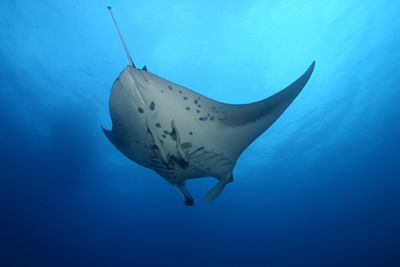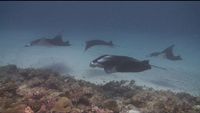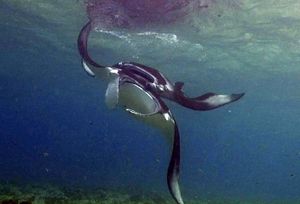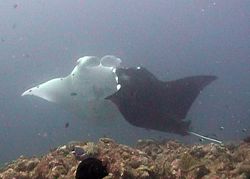Overview
Alfred or Reef Mantas (Mobula alfredi) are found circumtropically whilst the giant mantas (Mobula birostris) are found in tropical and more temperate areas. Both species are regularly seen by fishermen and sports divers but due to the lack of importance to commercial fisheries they had not been studied in any great depth until the past 15 years. There has been an enormous increase in the amount of published information from observations and tracking of mantas in populations in the Maldives, Mozambique, Red Sea, Australia, Gulf of Mexico, Revillagigedos islands (Mexico), Ecuador, Indonesia, and Japan.

Origins of the Manta Ecology Project
I worked as a dive guide in the Maldives, taking guest divers to various sites including weekly visits to sites known as “Manta Points” which are established cleaning stations which the mantas visit in order to be cleaned of dead skin and parasites by a number of, typically, wrasse, species. I was unable to answer questions about whether the mantas were the same on each visit or whether they visited every week or how long they cleaned for. There was no information in readily available references nor from marine biologists I was in contact with. I developed a manta identification system based on website information from researchers in Yap, Japan and Australia that the markings on the ventral side of the manta were individual. There was no written method, nor other information specifically about how to use the markings so the first step was to develop a rigorous identification method. The method was honed over a period of around three months (December 01 to February 02) and has been used successfully for over 23 years now. The method can be used to identify all manta species and colour types (chevron” and “black”).
Contributions from a number of sources are included in the database.
In September 2005 a special Microsoft Access database was developed and all the records were transferred to this.
Mantas are very much part of the culture of the Maldives. There is no commercial fishery but many islands and reefs are named from local fishermen’s observations of mantas in the locality and it has been known a very long time that mantas are seen on the lee side of the atoll to the prevailing wind. The wind (monsoon) patterns are “North East”: November to April, and “South West”: May to October. Data collection has strongly supported the hypothesis that the mantas migrate from the east to the west side of the atolls with the movement of the plankton and the monsoon changes. Additionally we have a smaller proportion of mantas identified in different atolls, requiring them to traverse water minimum 350m deep and some gaps between the atolls are over 1500m deep. Reef mantas have been reported from the far north travelling to central atolls and far south to central. I can hypothesize that mantas may travel further south towards Chagos archipelago and north to Lakshadweep archipelago (India) and therefore across national borders where no protection occurs. To date no Maldives mantas have been reported elsewhere.
In addition to making records of mantas seen during regular tourist dives, extended observation as at the cleaning stations were performed in order to answer the following:
1. How long a manta spends cleaning in one day or cleaning period? (simple answer is 5-240+ minutes)
2. How many mantas visit a cleaning station in a day (period of daylight hours)? (over 110 recorded over a 10 hour observation window)
3. Which other fish are involved in the cleaning act and how many?
4. What are the effects of currents and tides on the presence of mantas?
They also provided excellent opportunities to observe and describe novel behaviour.
Behaviour
The only manta behaviour to have been previously described in detail is copulation.
A number of novel behaviours have been described from these observations.
1. Arriving. A manta arrives at the cleaning station and makes their presence known to other mantas by form of a formalised greeting. The mantas arrive to the cleaning station by swimming in from deep water and by swimming parallel to the reef for some distance, sometimes making several passes of the cleaning station before settling down and clean. Arriving may also encompass some demonstrating behaviour as a large manta may arrive with a group of mantas and then swim away leaving the other mantas to clean.
2. Greeting. If other mantas are already present at the cleaning station the arriving manta faces other mantas in cleaning circle and watches them to ascertain position in hierarchy. In some cases the manta will slip in behind all the other mantas once it has “greeted” them all and in some cases a “Head Off” will occur.
3. Cleaning circles (video link). Groups of 2+ mantas swim in tight circles over reef area where there is high concentration of cleaners. If there is significant current so the mantas have to swim into the current the circle will be replaced by a line and mantas take it in turns to swim to the front of the line, clean and the drop to the back and allow another to take their place. Mantas need to keep swimming to funnel water over their gills so they can continue to breathe. Swimming (or hovering) into a strong current serves the same purpose.


4. Courting. Male manta mounts female and stimulates her by rubbing her dorsal surface with his cephalic fins as precursor to mating. Juvenile males are often observed mounting large pregnant females. This may be practice mating.

5. Head Off. Threatening (agonistic) behaviour towards rival manta for priority at cleaning station.

The mantas swim at each other, head to head, then swim up belly to belly and appear to compare size. The larger manta holds position and hovers steadily whilst the smaller manta will swim down and away.
6. Bubbling. Some mantas purposefully swim through exhaled bubbles from divers as part of cleaning procedure. Some mantas have developed advanced techniques in this behaviour and have been observed compressing swallowed bubbles through their gill slits. Not all mantas like bubbles.
7. Demonstrating. Large females showing smaller males and females bubbling techniques. The large one does it first then waits around until the smaller one does it. Large female mantas also lead smaller mantas to the cleaning station and then swim away as if showing the smaller ones where it is.
8. Collecting/Departing. Manta arrives to group and swims away, leading other mantas away with it.
9. Jumping out of water. This behaviour is regularly observed and there is no clear explanation. A manta was observed swimming vertically up a distance of 15m before leaping clear out of the water, landing on her dorsal side (others have been observed performing this behaviour and landing on ventral side) and then swimming down to 15m again and continuing her cleaning routine.
10. Hierarchal display. With large numbers of mantas present, the mantas may be seen swimming very closely over the divers as long as they remain immobile and close to the reef. This appears to be an attempt to physically displace the diver.
The altruistic behaviours are currently being researched. Contact me Anne-Marie for further information.
